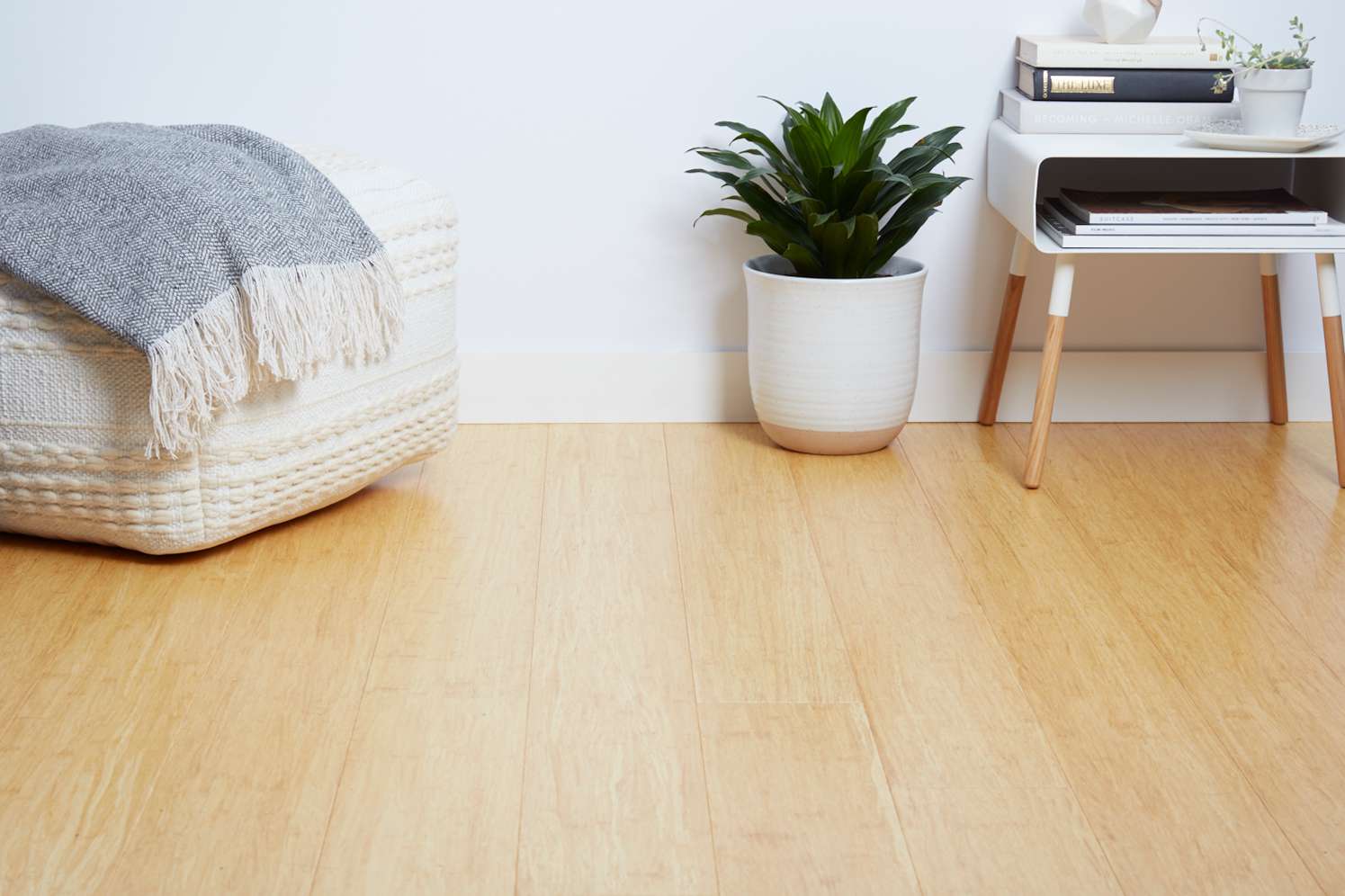Exploring Various Flooring Options: A Comprehensive Consumer Guide
List of Flooring Choices:
1. Hardwood
2. Engineered Wood
3. Bamboo
4. Laminate
5. Linoleum
6. Cork
7. Ceramic Tiles
8. Carpet
9. Stone
10. Vinyl
11. Polished Concrete
The choice of flooring can significantly impact the ambiance of a specific room. For instance, while hardwood flooring is a popular option for a wooden floor, it may not be suitable if you plan to cover it with carpet in a master bedroom.
To make an informed purchasing decision, it is crucial to explore all the different flooring types available. Therefore, let us present to you our detailed flooring guide (apologies for the pun, couldn’t resist). We will introduce each type of flooring and provide additional articles that delve deeper into the popular options.
Flooring Cost Comparison:
Search:
Floor Type Lowest Material Cost
(per sq ft) Highest Material Cost
(per sq ft) Professional Installation Cost
(per sq ft)
Hardwood $10.00 $20.00 $12.00
Engineered Hardwood $4.00 $10.00 $10.00
Laminate $2.00 $7.00 $10.00
Vinyl $1.25 $5.00 $10.00
Carpet $3.00 $20.00 $7.50
Tile (Slate) $4.00 $15.00 $12.00
Displaying 1 to 6 of 6 entries
Exploring the Array of Flooring Options
Although numerous flooring types are available, some are more commonly seen in modern homes than others.
Within each category, additional design choices may still need to be made. Factors such as the specific material for wood or stone floors, as well as color, stains, finishes, or patterns, might require consideration.
Now, let’s dive into the most popular choices and explore the advantages and disadvantages of each option.
Related: Visualize Different Flooring in Your Rooms with Six Floor Design Software Options.
1. Hardwood Floors
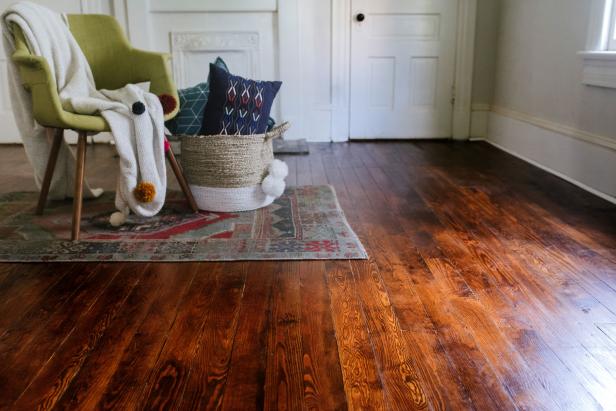
Hardwood flooring consists of single pieces of hardwood cut from a tree of your preference. Oak, cherry, and walnut are commonly used, but other solid wood options are also available.
Typically, planks are three-quarters of an inch thick, with a width ranging from three to five inches, referred to as a ‘medium’ or ‘standard’ plank. Wide planks, measuring between five and ten inches, are another stylish option suitable for various living spaces.
Hardwood floors can be pre-finished, with the finish applied before installation, or unfinished, requiring sanding and finishing after installation for a shiny and moisture-resistant surface.
Different wood species vary in hardness, as indicated by the Janka hardness rating scale. Choosing a wood type appropriate for the room’s foot traffic is crucial to minimize wear and tear.
The cost of hardwood flooring ranges from $3 to $8 per square foot, with exotic varieties reaching up to $14 per square foot. Installation costs vary by location, averaging $5 to $12 per square foot.
2. Engineered Wood Flooring
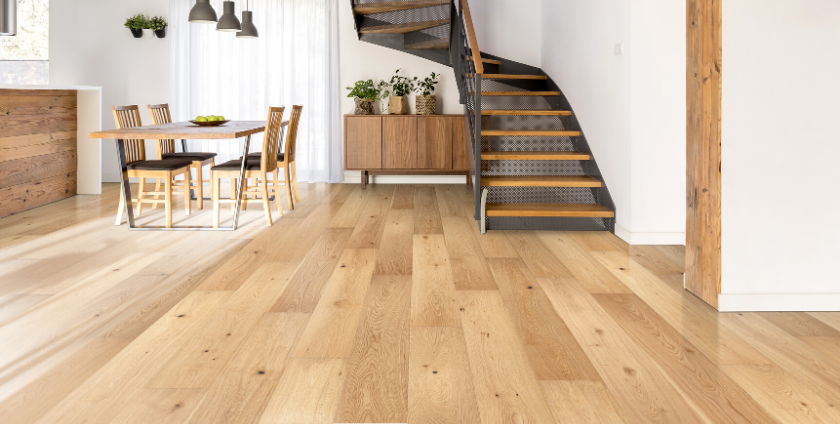
Engineered hardwood offers a more affordable alternative to solid hardwood. It combines a top layer of genuine hardwood with multiple layers of ply plank beneath, providing improved resistance to moisture.
Engineered wood is ideal for areas where concerns about warping due to high humidity exist, such as damp basements. Moreover, as it utilizes less expensive solid wood, it is a cost-effective option for those who desire plank flooring.
Keep in mind that engineered wood cannot be sanded or refinished as frequently as true hardwood due to its thin top veneer. However, it can still be coated with high-quality finishes to enhance its durability.
Similar to hardwood floors, engineered wood offers a variety of wood species, plank sizes, and finishes.
Discover the 40 different types of engineered wood flooring available.
3. Bamboo Flooring
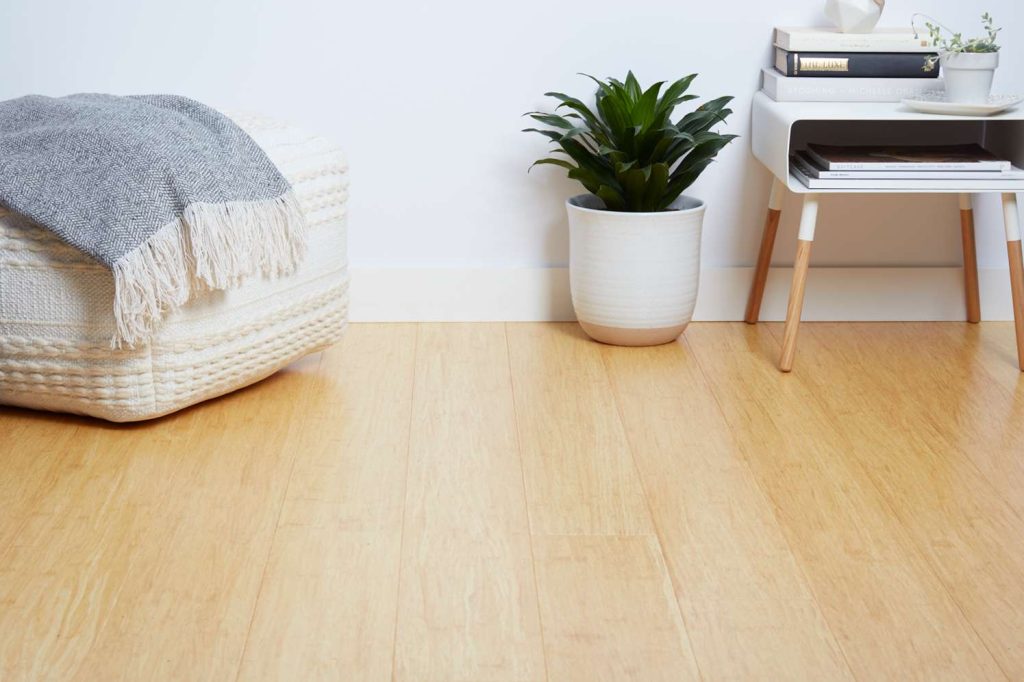
Although bamboo falls under the hardwood category, it stands out as a sustainable and eco-friendly option. It shares a comparable hardness to oak and offers a light wood color naturally, but it can be treated to achieve darker finishes resembling stained wood.
Most bamboo flooring is made from Moso bamboo imported from China. This plant, belonging to the grass family, can grow over 70 feet high in under 60 days. It is a renewable resource that does not require extensive water, pesticides, or herbicides for cultivation. Bamboo matures in approximately five years, making it a quick and replenishable supply.
Due to its environmental friendliness, many types of bamboo floors meet the prestigious LEED Certification standards.
The cost of bamboo flooring ranges from $3 to $8 per square foot, with installation costs ranging from $7 to $12 per square foot.
4. Laminate Flooring

If the cost of hardwood is beyond your budget but you desire its appearance, laminate flooring provides an attractive alternative.
Similar in design to engineered wood, laminate flooring consists of a top layer finished and sealed over layers of plywood or compressed fiber, resulting in stable and durable planks.
The key difference between laminate and real wood flooring is the absence of a real wood top layer in laminate. Instead, photo-realistic technology captures images of wood, stone, ceramic tile, or stained concrete, which are then covered with a protective plastic coating. The result is laminate versions that closely resemble the real materials at a fraction of the cost.
The price of laminate flooring ranges from $1 to $7 per square foot, depending on the quality, with installation costs varying from $2 to $5 per square foot based on complexity.
Use our laminate flooring cost calculator for more accurate estimates.
5. Linoleum Flooring
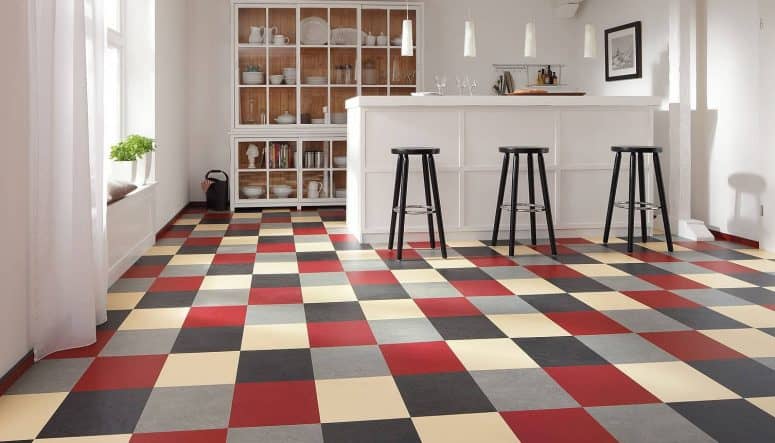
Linoleum has come a long way since the 1970s and now offers numerous attractive options beyond the dated kitchen appearance.
Made from renewable and biodegradable materials like linseed oil and cork, linoleum is considered an environmentally friendly flooring choice.
Available in sheet form, linoleum is installed by directly gluing it to the floor. The sheets come in various colors and patterns, featuring mineral pigments. Sealing them with a protective coating ensures longevity and prevents staining and wear.
Linoleum with proper protection can last a long time. However, without it, refinishing every two years may be necessary to maintain a fresh appearance.
Linoleum flooring costs between $2 and $5 per square foot, with installation costs ranging from $7 to $12 per square foot.
6. Cork Flooring

For an environmentally conscious option, cork flooring provides a solution with minimal impact. Cork is harvested from tree bark without harming the trees, as the bark regenerates every eight to ten years.
Cork flooring offers a warm appearance similar to wood, with unique grain patterns that may include speckles and swirls. It is available in tiles or planks and constructed similarly to laminate flooring, with a top layer glued to a stable core material.
Most cork products come pre-finished, but resealing every three to five years is recommended to protect against moisture and stains. Polyurethane or wax are common sealers used for this purpose.
In terms of cost, cork flooring ranges from $2 to $6 per square foot, with installation adding an additional $3 to $5 per square foot.
7. Ceramic Tiles
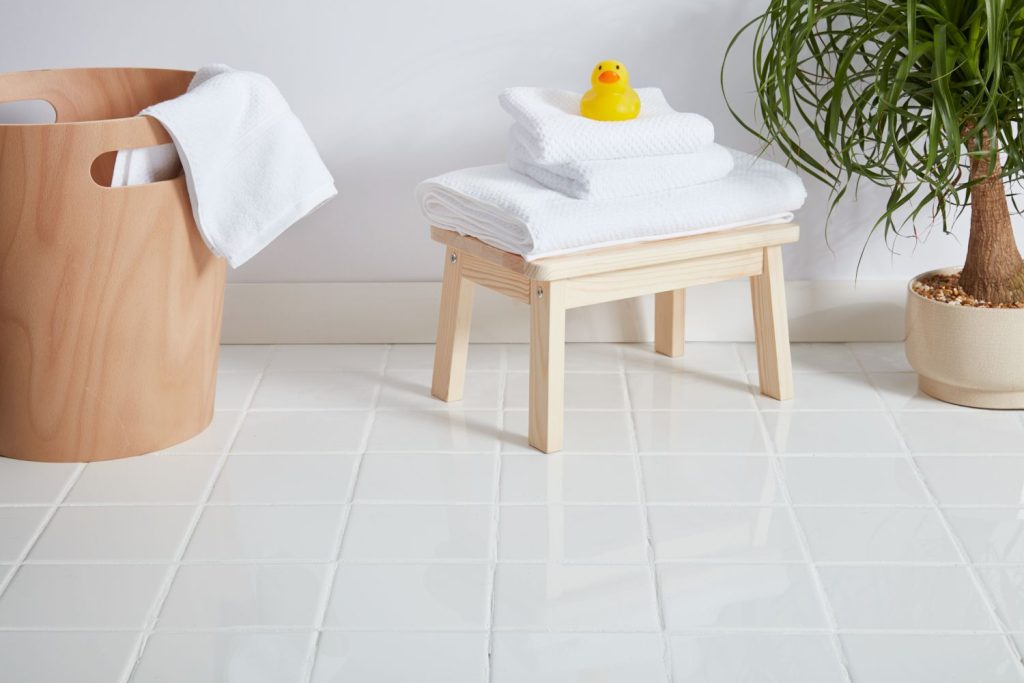
Ceramic tiles are renowned for their versatility, with a wide range of colors, textures, shapes, and sizes to complement any room in your home.
These tiles are created by combining clay and shale, firing them in a kiln to harden the ceramic. The addition of pigments provides various color options.
To ensure durability, it is important to choose tiles specifically rated for use on floors, preferably with anti-slip finishes that meet slip-resistance standards.
Ceramic tile prices vary based on factors such as size, quality, and design. It is possible to find ceramic tiles at different price points to suit your budget and preferences.
Conclusion:
Exploring different types of flooring is crucial when making a purchasing decision for your space. Consider factors such as material, durability, cost, and environmental impact to find the perfect flooring option that meets your needs and enhances the aesthetic appeal of your home.
8. Carpet

Carpeting is a popular choice for creating a cozy and comfortable atmosphere in various rooms. It comes in a wide range of colors, textures, and patterns to suit different interior styles.
Carpet is made from fibers, such as nylon, polyester, or wool, which are woven together to create a soft and plush surface. It provides insulation, absorbs sound, and offers a comfortable underfoot feel.
When choosing carpet, consider factors such as durability, stain resistance, and maintenance requirements. Different carpet styles, such as plush, Berber, or frieze, offer distinct characteristics and appearances.
Carpet prices can vary greatly depending on the quality and type of fibers used. Expect to pay between $3 and $20 per square foot for the carpet itself. Installation costs, on average, range from $7.50 to $20 per square foot.
9. Stone

Stone flooring adds a touch of elegance and natural beauty to any space. Options like marble, granite, limestone, and travertine offer unique patterns, colors, and textures.
Stone floors are highly durable and can withstand heavy foot traffic. They are also naturally resistant to moisture, making them suitable for areas prone to spills or high humidity.
The cost of stone flooring varies depending on the type of stone chosen. It can range from $4 to $15 per square foot for the material alone. Professional installation costs around $12 per square foot on average.
10. Vinyl
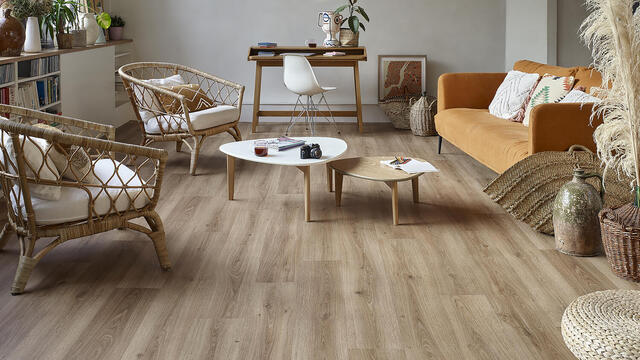
Vinyl flooring is a versatile and budget-friendly option that mimics the look of hardwood, tile, or stone. It comes in various styles, including sheets, tiles, or planks, offering flexibility in installation.
Vinyl flooring is known for its durability, water resistance, and easy maintenance. It is an ideal choice for high-traffic areas, kitchens, and bathrooms.
The cost of vinyl flooring ranges from $1.25 to $5 per square foot for the material. Professional installation costs approximately $10 per square foot.
11. Polished Concrete
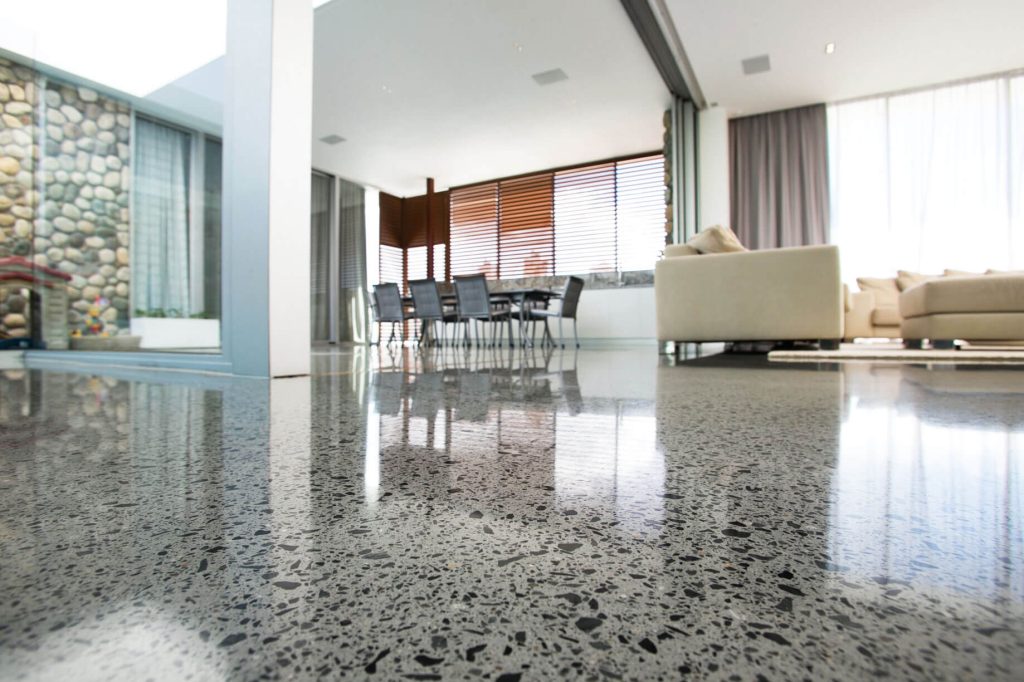
Polished concrete floors are gaining popularity for their sleek and modern appearance. This flooring option involves grinding and polishing a concrete surface to achieve a smooth and glossy finish.
Polished concrete is highly durable, easy to clean, and offers excellent thermal conductivity. It can be customized with various colors, stains, and decorative patterns.
The cost of polished concrete flooring varies depending on factors such as the condition of the existing concrete and the desired level of customization. On average, expect to pay between $4 and $15 per square foot.
In conclusion, exploring the different types of flooring allows you to find the perfect option that meets your aesthetic preferences, budget, and functional needs. Whether you prefer the timeless elegance of hardwood, the eco-friendly properties of bamboo, or the versatility of vinyl, there is a flooring choice available to transform your space. Consider the pros and cons of each type and consult professionals for installation and maintenance advice to ensure a successful flooring project.
Frequently Asked Questions
Is waterproof vinyl flooring available?
Vinyl flooring, a relatively recent addition to the market, offers numerous advantages. Firstly, it is highly resistant to water, making it an excellent choice for high-traffic areas or rooms prone to moisture. Installation and maintenance are effortless, and it comes in a wide range of colors and patterns to suit any style. Moreover, vinyl flooring is budget-friendly, making it an ideal option for cost-conscious shoppers.
What is the best type of wood for flooring?
Wood flooring is favored for its durability and timeless appeal. For high-traffic areas, hardwoods like oak and maple are excellent choices due to their resistance to scratches and dents. Engineered wood or bamboo, on the other hand, offer a softer and more elegant look. For a distinctive aesthetic, consider reclaimed wood flooring.
Which vinyl flooring is the most preferable?
Luxury vinyl plank flooring stands out as a superior option compared to traditional vinyl flooring. It replicates natural wood and stone with remarkable realism in terms of colors and styles. Additionally, luxury vinyl plank flooring offers enhanced durability and easier installation compared to traditional vinyl flooring. If you’re seeking the best vinyl flooring for your home, luxury vinyl plank flooring is highly recommended.
Can vinyl flooring be painted?
While pre-painted vinyl flooring is available, it may surprise many to learn that it’s possible to paint vinyl flooring oneself. Painting vinyl flooring offers a cost-effective way to give your home a fresh new look. The process is relatively simple but requires selecting the appropriate paint type and adequately preparing the surface. For optimal results, opt for floor paint specifically designed for vinyl use, thoroughly clean the flooring, and lightly sand it before painting.
Which type of tiles is best for flooring?
Choosing tile flooring involves decisions regarding material, color, texture, and pattern. Here are some factors to consider:
– In larger rooms, large tiles create a more spacious feel, while small tiles add coziness to smaller spaces.
– For a formal look, opt for larger tiles, while smaller tiles suit a more casual aesthetic.
– Darker colors tend to make a room appear smaller, while lighter colors create a sense of openness.
– Busy patterns can make a room feel smaller, while simpler patterns contribute to a more expansive feel.
How much flooring do I require?
Flooring is typically sold by the square foot. To calculate the amount needed, multiply the length of your room by its width to determine the total square footage.
Can steam mops be used on vinyl plank flooring?
Using a steam mop is an effective method for cleaning vinyl plank flooring.
Is underlayment necessary for vinyl flooring?
Underlayment may be necessary for vinyl flooring if the subfloor is uneven, the subfloor is made of concrete, or additional insulation is desired. However, certain types of vinyl flooring already come with attached underlayment, so it’s advisable to check before making a purchase.
Which flooring is best for households with dogs?
There isn’t a definitive answer as dogs’ preferences vary. While many believe carpet is ideal for dogs due to its softness and comfort, our dog survey did not yield significant responses. Hardwood and laminate flooring are generally suitable options for homes with dogs. Vinyl flooring is also a good choice due to its easy cleaning and maintenance. However, ensure the flooring is durable and scratch-resistant.
Can bamboo flooring be refinished?
Bamboo flooring can be refinished, but the process is slightly more intricate than refinishing other hardwood floors. Different types of bamboo flooring require different approaches to refinishing. The thickness of the top bamboo layer varies depending on the grade. Thin top layers may pose challenges, but high-quality bamboo flooring with a thick bamboo layer can be refinished similar to other hardwood floors.
How often should I clean my tile floors?
In most cases, sweeping or vacuuming
the floors and mopping them with a mild detergent once a week is sufficient.
Will acetone cause damage to vinyl flooring?
Acetone is a potent chemical that can harm various types of flooring, including vinyl.
Should flooring be installed under cabinets?
Yes, flooring should be installed wall to wall, including under cabinets and appliances, for a seamless and complete look.
